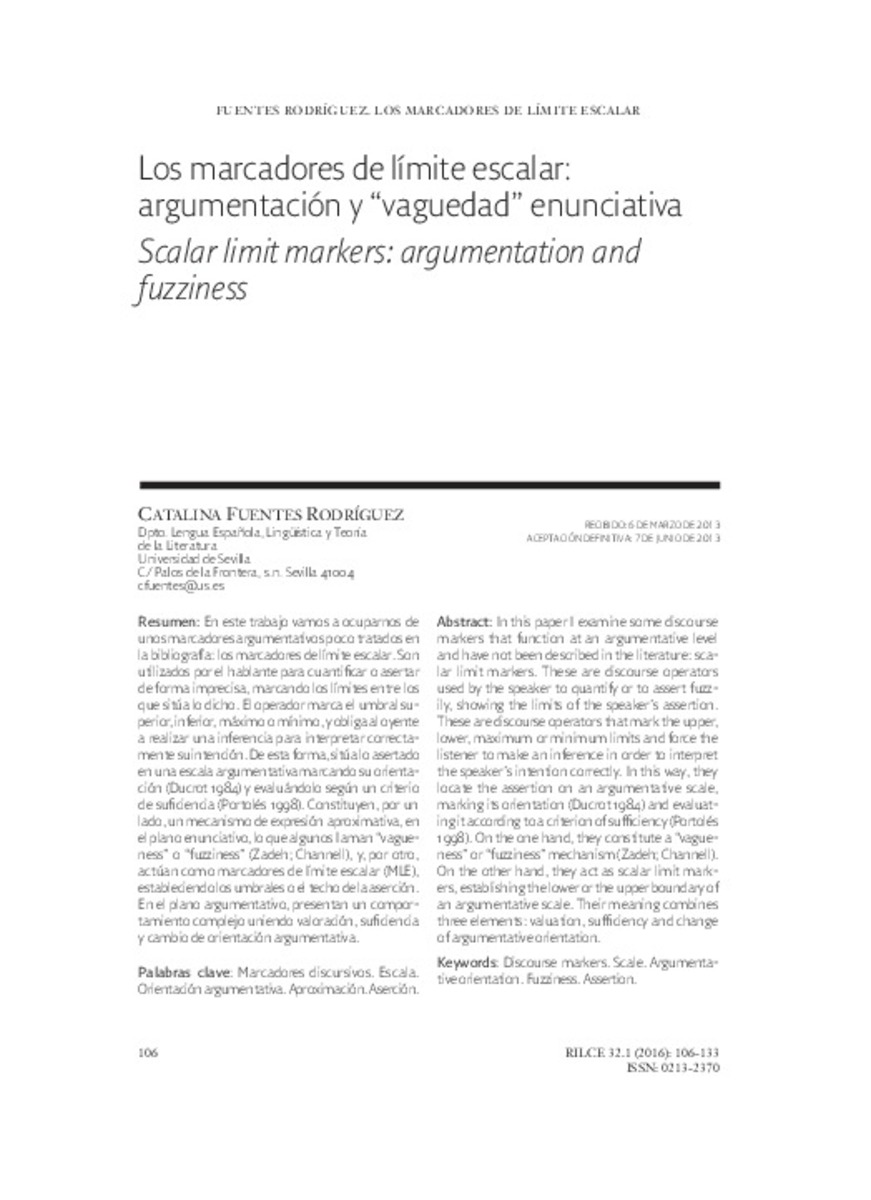Full metadata record
| DC Field | Value | Language |
|---|---|---|
| dc.creator | Fuentes-Rodríguez, C. (Catalina) | - |
| dc.date.accessioned | 2016-10-11T15:44:28Z | - |
| dc.date.available | 2016-10-11T15:44:28Z | - |
| dc.date.issued | 2016 | - |
| dc.identifier.citation | Fuentes-Rodríguez, C., ""Los marcadores de límite escalar: argumentación y “vaguedad” enunciativa"", Servicio de Publicaciones de la Universidad de Navarra, Vol.32.1, (2016), pp. 106-133 | es_ES |
| dc.identifier.issn | 0213-2370 | - |
| dc.identifier.uri | https://hdl.handle.net/10171/41733 | - |
| dc.description.abstract | In this paper I examine some discourse markers that function at an argumentative level and have not been described in the literature: scalar limit markers. These are discourse operators used by the speaker to quantify or to assert fuzzily, showing the limits of the speaker’s assertion. These are discourse operators that mark the upper, lower, maximum or minimum limits and force the listener to make an inference in order to interpret the speaker’s intention correctly. In this way, they locate the assertion on an argumentative scale, marking its orientation (Ducrot 1984) and evaluating it according to a criterion of suffi ciency (Portolés 1998). On the one hand, they constitute a “vagueness” or “fuzziness” mechanism (Zadeh; Channell). On the other hand, they act as scalar limit markers, establishing the lower or the upper boundary of an argumentative scale. Their meaning combines three elements: valuation, suffi ciency and change of argumentative orientation. | es_ES |
| dc.description.abstract | En este trabajo vamos a ocuparnos de unos marcadores argumentativos poco tratados en la bibliografía: los marcadores de límite escalar. Son utilizados por el hablante para cuantifi car o asertar de forma imprecisa, marcando los límites entre los que sitúa lo dicho. El operador marca el umbral superior, inferior, máximo o mínimo, y obliga al oyente a realizar una inferencia para interpretar correctamente su intención. De esta forma, sitúa lo asertado en una escala argumentativa marcando su orientación (Ducrot 1984) y evaluándolo según un criterio de sufi ciencia (Portolés 1998). Constituyen, por un lado, un mecanismo de expresión aproximativa, en el plano enunciativo, lo que algunos llaman “vagueness” o “fuzziness” (Zadeh; Channell), y, por otro, actúan como marcadores de límite escalar (MLE), estableciendo los umbrales o el techo de la aserción. En el plano argumentativo, presentan un comportamiento complejo uniendo valoración, suficiencia y cambio de orientación argumentativa | es_ES |
| dc.language.iso | spa | es_ES |
| dc.publisher | Servicio de Publicaciones de la Universidad de Navarra | es_ES |
| dc.rights | info:eu-repo/semantics/openAccess | es_ES |
| dc.subject | Aserción | es_ES |
| dc.subject | Aproximación | es_ES |
| dc.subject | Orientación argumentativa | es_ES |
| dc.subject | Escala | es_ES |
| dc.subject | Marcadores discursivos | es_ES |
| dc.title | Los marcadores de límite escalar: argumentación y “vaguedad” enunciativa | es_ES |
| dc.title.alternative | Scalar limit markers: argumentation and fuzziness | - |
| dc.type | info:eu-repo/semantics/article | es_ES |
| dc.identifier.doi | 10.15581/008.32.2970 | es_ES |
Files in This Item:
Statistics and impact
Items in Dadun are protected by copyright, with all rights reserved, unless otherwise indicated.






